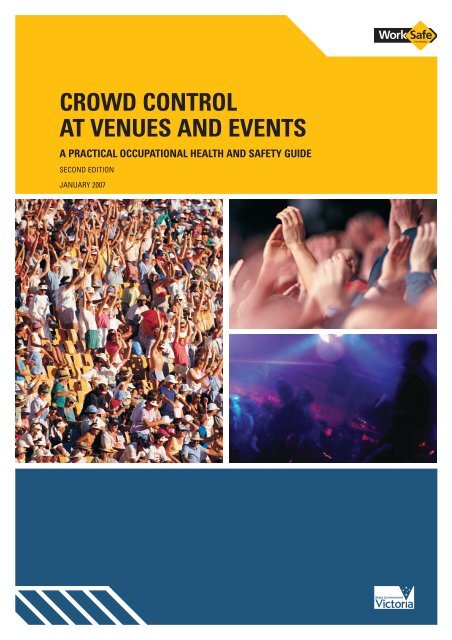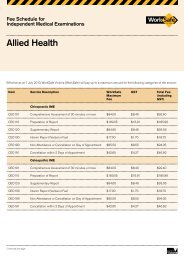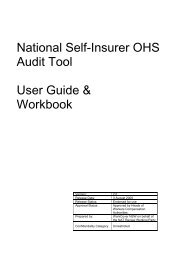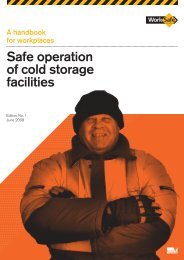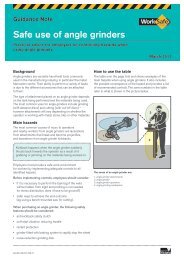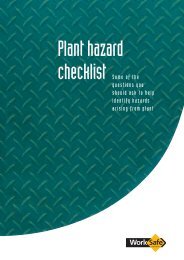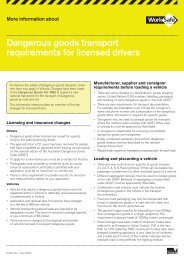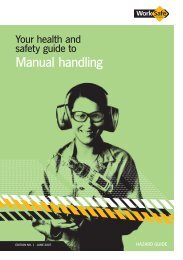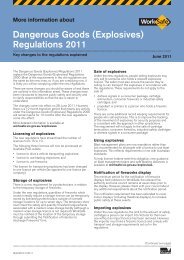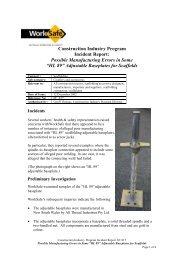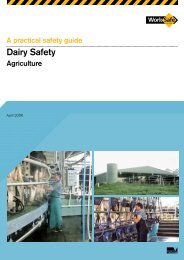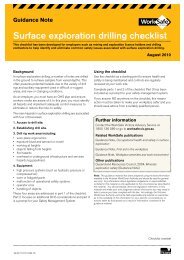Crowd Control At Venues And Events (PDF ... - WorkSafe Victoria
Crowd Control At Venues And Events (PDF ... - WorkSafe Victoria
Crowd Control At Venues And Events (PDF ... - WorkSafe Victoria
- No tags were found...
Create successful ePaper yourself
Turn your PDF publications into a flip-book with our unique Google optimized e-Paper software.
CROWD CONTROLAT VENUES AND EVENTSA PRACTICAL OCCUPATIONAL HEALTH AND SAFETY GUIDESECOND EDITIONJANUARY 2007
CONTENTSPart one: Introduction . . . . . . . . . . . . . . . . . . . . . . . . . . . . 11.1 What does this Guide aim to do? . . . . . . . . . . . . . . 11.2 Frequently used terms . . . . . . . . . . . . . . . . . . . . . . 21.3 <strong>Crowd</strong> control and OHS . . . . . . . . . . . . . . . . . . . . . 31.4 The role of this Guide under the OHS Act 2004 . . . 41.5 How to use this Guide . . . . . . . . . . . . . . . . . . . . . . 4Part two: Safety assessment and consultation . . . . . . 52.1 <strong>Control</strong>ling the risks – placing crowd controllersinto safe workplaces. . . . . . . . . . . . . . . . . . . . . . . . 52.2 Talking safety – workplace consultation . . . . . . . . . 8Part three: <strong>Crowd</strong> control risk solutions . . . . . . . . . . . 113.1 <strong>Control</strong>ling entry into a venue or event . . . . . . . . . 123.2 Monitoring and communicating on crowd andindividual behaviour. . . . . . . . . . . . . . . . . . . . . . . . 15Part four: Incident reporting. . . . . . . . . . . . . . . . . . . . . . 254.1 What incidents need to be reported to<strong>WorkSafe</strong> <strong>Victoria</strong>? . . . . . . . . . . . . . . . . . . . . . . . . 254.2 Why report notifiable incidents? . . . . . . . . . . . . . . 264.3 Preserving a notifiable incident site. . . . . . . . . . . . 26Part five: Further information. . . . . . . . . . . . . . . . . . . . . 27Appendices. . . . . . . . . . . . . . . . . . . . . . . . . . . . . . . . . . . . 29Appendix 1 <strong>Crowd</strong> control safety and securityrisk assessment . . . . . . . . . . . . . . . . . . . . 30Appendix 2 <strong>Crowd</strong> control agency placementinduction checklist . . . . . . . . . . . . . . . . . . 37Appendix 3 Host employer placement inductionchecklist . . . . . . . . . . . . . . . . . . . . . . . . . . 38Appendix 4 Incident notification form . . . . . . . . . . . . . 393.3 Dealing with potentially aggressive, abusive orviolent behaviour. . . . . . . . . . . . . . . . . . . . . . . . . . 183.4 Physically managing aggressive, abusive orviolent behaviour. . . . . . . . . . . . . . . . . . . . . . . . . . 203.5 Administering and coordinating ‘first response’first aid or critical care . . . . . . . . . . . . . . . . . . . . . . 223.6 Coordinating emergency evacuation of a venueor event . . . . . . . . . . . . . . . . . . . . . . . . . . . . . . . . 23The information presented in the <strong>Crowd</strong> <strong>Control</strong> at <strong>Venues</strong> and <strong>Events</strong> guide isintended for general use only. It should not be viewed as a definitive guide to the law,and should be read in conjunction with the Occupational Health and Safety Act 2004.Whilst every effort has been made to ensure the accuracy and completeness of theguide, the advice contained herein may not apply in every circumstance. Accordingly,the <strong>Victoria</strong>n WorkCover Authority cannot be held responsible, and extends nowarranties as to:• the suitability of the information for any particular purpose;• actions taken by third parties as a result of information contained in the<strong>Crowd</strong> <strong>Control</strong> at <strong>Venues</strong> and <strong>Events</strong> guide.The information contained in this publication is protected by copyright. The <strong>Victoria</strong>nWorkCover Authority hereby grants a non-exclusive licence in this publication to therecipient of this publication on the condition that it is not disseminated for profit.The <strong>Victoria</strong>n WorkCover Authority encourages the free transfer, copying and printingof the information in this publication if such activities support the purposes and intentfor which the publication was developed.
1INTRODUCTION11.1 WHAT DOES THIS GUIDE AIM TO DO?Managing crowds involves significant risk. The extent, severity and exposure to riskwill vary depending on: the circumstances crowd controllers find themselves in;how well crowd control staff have been prepared; and how effectively risks havebeen controlled.This Guide has been developed to support and assist crowd control agencies andhost employers (venues and events) who use crowd control staff to understandand fulfil their responsibilities under the Occupational Health and Safety Act 2004(the OHS Act).This Guide identifies common safety problems and suggests solutions to ensurecrowd control work is conducted as safely as it reasonably can be. It also providesnumerous recommendations and tools to effectively secure the health, safety andwelfare of crowd control staff, as well as other staff and patrons, when:• controlling entry into venues or events;• monitoring and communicating on crowd and individual behaviour;• dealing with potentially aggressive, abusive or violent behaviour;• physically managing aggressive, abusive or violent behaviour;• administering and coordinating ‘first response’ first aid or critical care; or• coordinating emergency evacuation of a venue or event.In preparing this publication, <strong>WorkSafe</strong> <strong>Victoria</strong> sought the input of representativesfrom crowd control industry bodies, regulators, employers, employees and otherkey stakeholders (a list of whom can be found in the acknowledgments section onpage 28).WORKSAFE VICTORIA / CROWD CONTROL AT VENUES AND EVENTS 1
2SAFETY ASSESSMENTAND CONSULTATION22.1 CONTROLLING THE RISKS – PLACING CROWD CONTROLLERSINTO SAFE WORKPLACESManaging crowds involves significant risk. The extent, severity and exposure torisk will vary depending on: the circumstances that crowd controllers findthemselves in; how well they have been prepared; and how effectively risks havebeen identified, assessed and controlled. To fully appreciate the risks involved in anybusiness, time needs to be taken to investigate, identify and assess them.How to manage risk?Fundamentally, risk management involves the following four key steps.1. Identify and list the hazards that have the potential to cause an injury.This involves using information and input from all resources, includingemployees, HSR’s, previous incident records, publications (such as this Guide),industry experts and, most importantly, your own eyes and ears (look at what’sgoing on in your workplace and listen to what people are saying). In ‘OHSspeak’ this is called ‘identifying hazards’. Work together with employees andask them what they believe could cause an injury. This should produce a largelist of hazards. Don’t dismiss any ideas.2. Assess the risks. During step one, you identified a whole range of hazards andnow it’s time to work out whether each hazard could be the cause of a genuinesafety problem. Many people make mistakes at this point because they fail toreally appreciate the ‘source’ or primary reason why the risk exists in the firstplace. It’s important that when you’re assessing the source of a risk you askyourself the ‘why’ question. Asking ‘why?’ often enough will progressivelybreak down a risk scenario to the actual ‘source’ itself. You then have a betterchance of implementing a control that will more effectively manage the risk.Consider this simple example that illustrates the basic process of assessinga risk:• Q. What is the risk?• A. Being hit by cars.• Q. Why?• A. Because we have to stand on the road.• Q. Why do you stand on the road?• A. Because we have to direct patrons to stay off the road after theycome out of the venue.WORKSAFE VICTORIA / CROWD CONTROL AT VENUES AND EVENTS 5
SAFETY ASSESSMENT AND CONSULTATION• Q. Why do they go on to the road?• A. Because when they leave there is not enough space for them and thosetrying to get in.• Q. Why is there not enough room?• A. Because the other entrance is blocked by speaker stacks and we can’t usethat door.• Solution: Implement a potentially expensive traffic management plan;or simply relocate the speaker stacks, open the second entranceand eliminate the risk.As the example above demonstrates, not asking ‘why?’ can lead to complicatedcontrols being unnecessarily implemented when a simpler control would havebeen more effective. Obviously some hazards will need capital expenditure toproperly control them.3. Prioritising the risks. Once risks have been assessed, the next step is toprioritise them for remedial action. To help you do this, the risk analysis matrixbelow is a useful tool. Used by many other industries to prioritise risk, itinvolves asking two fundamental questions for each assessed risk:• What is the likelihood of the risk occurring?• What would be the consequence should the risk occur?Regardless of the priority ranking given to each identified and assessed risk,it’s important to remember that all risks should be controlled in the shortestpossible timeframe.RISK ANALYSIS MATRIXCONSEQUENCELIKELIHOOD Insignificant Minor Moderate Major CatastrophicAlmost certain H H E E ELikely M H H E EPossible L M M E EUnlikely L L M H ERare L L L H HL = Low risk M = Medium risk H = High risk E = Extreme riskIn the example used above, the likelihood of a crowd controller being hit by acar may be determined as ‘likely’. The consequence of being hit by a car isdetermined as ‘major’, i.e. serious injuries could be sustained by a crowdcontroller. Therefore, the overall priority would be scored as ‘E – Extreme risk’and should be controlled immediately.6 WORKSAFE VICTORIA / CROWD CONTROL AT VENUES AND EVENTS
SAFETY ASSESSMENT AND CONSULTATION24. <strong>Control</strong> the risks. This is the most important part of the entire process.Risk can be controlled in a number of ways, but the first objective should beto eliminate the risk entirely. If this is not possible, exposure to risk should bereduced as much as is ‘reasonably practicable’. The process often used to assistin this is known as the ‘hierarchy of control’. When choosing a control, start atthe top of the hierarchy (i.e. elimination of the risk altogether) and if that’s notpracticable, move to the next level (i.e. ‘substitution’). The higher up the hierarchyyou are when implementing a control, the more effective the control will be inreducing the risks.It’s common to have to implement a number of controls to manage a riskeffectively. Using the previous example (i.e. under the second step of ‘assessthe risk’), moving the speaker stacks and opening the second entranceeliminates the need for crowd controllers to stand on the road. Introducing atraffic management plan is more time-consuming and expensive and could beless effective in reducing the risk of a crowd controller (and patrons) being hitby a car.It’s also important to note that there may be occasions when it will not alwaysbe possible to implement a selected risk control due to the effect of otherlegislative requirements. But this can’t be used as an excuse to avoid theobligation to fix a safety problem.For example, a host employer might decide that the best way to fix a serioussafety problem with vehicle traffic near the entrance to a venue would be toinstall pedestrian bollards at the front of the venue. However, local councilrequirements may prevent the construction of bollards. In this example, it wouldbe expected that the host employer would explore other options that will satisfythe council requirements or, if that’s unsuccessful, an alternative traffic controlsolution would be considered.HIERARCHY OF CONTROLMost effective ELIMINATION Eliminate the risk altogetherif possibleLeast effectiveSUBSTITUTIONMINIMISATIONENGINEERING CONTROLSADMINISTRATIVE/PROCEDURAL CONTROLSTRAINING/SUPERVISIONPERSONAL PROTECTIVEEQUIPMENTSubstitute the risk with somethingof less riskMinimise exposure required tothe riskDevelop an engineering solutionDevelop a policy and supportingproceduresTrain or supervise staffLowest level of the hierarchyWORKSAFE VICTORIA / CROWD CONTROL AT VENUES AND EVENTS 7
SAFETY ASSESSMENT AND CONSULTATION<strong>Crowd</strong> control safety and security risk assessmentAppendix 1 at the back of this Guide contains an example of a crowd controlsafety and security risk assessment form. The form is a good basic tool foridentifying, assessing and controlling risks associated with undertaking crowdcontrol activities. You can also use the form to help you create your own custommaderisk assessment process. The content of the assessment is closely linked tothe six key sections on crowd control covered in part three of this Guide.Who completes crowd control safety and security risk assessments?The assessments should be carried out by a person who understands theprocesses described in this Guide and who has experience in health, safety andcrowd control management. If the assessment is to be completed by in-housestaff, it is expected that the nominated person be an experienced member of staff.The host employer must be consulted during the assessment process, along withthose likely to be affected by the assessment where appropriate.Where crowd controllers are employed directly by a host employer, the crowdcontrol safety and security risk assessment must be completed by the hostemployer.2.2 TALKING SAFETY – WORKPLACE CONSULTATIONSafety at work for crowd controllers is best achieved and sustained when they areactively involved in the decision-making processes regarding issues that will, or arelikely to, affect their health, safety and welfare. Irrespective of this, it makes goodbusiness sense to ensure matters concerning a venue’s or event’s security arediscussed with those employed to administer such duties. This allows improvedopportunity to identify ‘gaps’ in the management of crowd control activities andmake necessary changes.Section 35 of the OHS Act requires all (agency and host) employers to consulttheir employees and independent contractors (i.e. crowd controllers), so far as isreasonably practicable, on matters that may directly affect employees’ health,safety or welfare. This must include, but is not limited to:• identifying or assessing hazards or risks arising from the activities of theemployer’s business;• deciding on measures to control these risks;• deciding on the adequacy of employee facilities;• confirming procedures for:– resolving health and safety issues arising from the activities of the employer’sbusiness;– consultation;– monitoring employee health and workplace conditions; and– the provision of information and training;• determining the membership of any health and safety committee (HSC); and• proposing changes that may affect OHS.Section 36 of the OHS Act details how employers are required to consult withtheir employees (and independent contractors) about health and safety mattersaffecting them. Basically, they must share information about OHS issues with theemployees, give them a reasonable opportunity to express their views on thosematters and take their views into account.8 WORKSAFE VICTORIA / CROWD CONTROL AT VENUES AND EVENTS
SAFETY ASSESSMENT AND CONSULTATION2Consulting about crowd control activitiesTo comply with sections 35 and 36 of the OHS Act, the agency and host employershould consult with crowd controllers about the following:• safety and security risk assessments;• crowd control safe systems of work (e.g. physically engaging patrons, entrycontrol, etc);• workplace policy or procedures (e.g. how workplace consultation will occur,emergency evacuation, etc);• implementation of risk control measures (e.g. surveillance equipment);• review of safety and security risk assessments and safe work practices;• changes or additions to facilities or amenities;• changes to workplace boundaries; and• changes to uniform or personal protective equipment (e.g. first aid kits,hearing protection, torch, etc).Resolution of health, safety and crowd control issuesWhen a crowd controller, or others associated with crowd control activities,have issues regarding their or others’ (e.g. patrons, other staff) health, safety andwelfare, the employers (agency, host employer or both) and employees affectedby the concerns must attempt to resolve them.Section 73 of the OHS Act outlines how workplace health and safety issues needto be resolved. The employer or their representative (i.e. manager, supervisor) andHSRs and/or employees affected by an issue must try to resolve their concernsusing agreed workplace procedures. If the issue can’t be resolved, a <strong>WorkSafe</strong>inspector can be called in to assist in this process. The employer or representativeattempting to address health and safety issues must be sufficiently senior andcompetent to act and make decisions.For more information on the duty to consult, please refer to <strong>WorkSafe</strong>’spublications Talking Safety Together and Consultation – A User’s Guide.Worker RepresentationThere is a variety of mechanisms that consultation can take place within theworkplace including OHS Committees and designated work groups. HSRs canprovide a crucial link between employers and their employees.HSRs provide employees with a mechanism to have their views and concerns onhealth and safety in their workplace heard by their employer. HSRs facilitatecommunication and consultation and the OHS Act gives them a role in raising andresolving any OHS issues with their employer, and powers to take issues further ifnecessary.The Act also provides flexibility in how and who HSRs can represent. Traditionallythe industry has not had HSRs but now the new Act provides agencies andvenues a means in which they can agree in consultation with their employees howrepresentation can be arranged within workplaces.For further information on Health and Safety Representatives can be gained fromthe <strong>WorkSafe</strong> <strong>Victoria</strong> publication Employee Representation.WORKSAFE VICTORIA / CROWD CONTROL AT VENUES AND EVENTS 9
SAFETY ASSESSMENT AND CONSULTATIONWorkplace inductionIt’s the responsibility of both the agency and host employer to ensure inductionis provided for the workplaces that they have control over.Inducting a new employee into the workplace is the first crucial step in ensuringtheir health, safety and welfare. Induction should be designed to provide the newemployee with the key information about safety at work, including:• a comprehensive understanding of hazards and risks associated with the work,including the risk of potentially violent encounters, manual handling injuries andeffects of fatigue;• the things in place to control risk at work, including the specific risk controlsolutions used and the overall system to manage safety at work;• knowledge of the hazard reporting and other reporting systems used for theworkplace; and• who is in control, roles and responsibilities.Appendix 2 contains an example induction checklist (<strong>Crowd</strong> <strong>Control</strong> (Agency)Placement Induction Checklist) for the agency. This checklist or similar should becompleted when the agency places an employee into a new workplace.Appendix 3 contains an example induction checklist (Host <strong>Crowd</strong> <strong>Control</strong>Placement Induction Checklist) for host employers. This induction checklist orsimilar should be completed by the host employer for each new crowd controllerused at the venue or event.Where a crowd controller is employed directly by the host employer, the hostemployer should ensure induction covers both induction checklists or similar.10 WORKSAFE VICTORIA / CROWD CONTROL AT VENUES AND EVENTS
3CROWD CONTROLRISK SOLUTIONS3This part of the Guide conveys the importance of dealing with obvious serioussafety risks first and quickly. Once the obvious risks have been dealt with, theperson in control can move on to more complex safety problems that require moredetailed risk assessments. All these assessments should be done in consultationwith employees and/or their elected representatives.It’s recommended that the tables on the following pages of this publication areused to ‘fast-track’ the risk assessment process. That is, if the solutions to rectifyunacceptable work practices at your workplace are obvious and straightforward toimplement, it should be done as soon as possible. Don’t delay putting in placegood OHS practices. A detailed risk assessment should follow. You might chooseto refine the solutions after the assessment, but it’s far more important to act onobvious risks quickly.Work practices described in the red tables are likely to be in breach of OHS lawsand almost invariably will be placing the health, safety and welfare of crowdcontrollers at risk. In some circumstances, the unacceptable work practices willalso be jeopardising the safety of the host employer’s employees and that ofpatrons. For example, unacceptable work practices dealing with emergencyprocedures. If you are using the work practices described in the red tables, youneed to determine ways to quickly stop doing those things and put in placeappropriate controls.The green tables list risk control solutions you should be using in your workplace,as long as they are reasonably practicable. You may not be able to implement therisk control solutions exactly as they are described in the green tables. If this is thecase, you should treat the suggested risk control solutions as benchmarks orindications of the type of solutions you are able to implement. It’s important tounderstand that these risk control solutions, although possibly not an ideal ‘fit’ foryour own workplace situation, are solutions generally regarded as quite practicablefor many workplaces in the crowd control sector.The tables include an indicative allocation of responsibility for rectifyingunacceptable work practices and putting into effect risk control solutions.UNACCEPTABLEWORK PRACTICESThe practices in the red column should notbe used at a venue or event. An agency orhost employer who allows these practicesto be used is likely to be in breach ofOHS legislation.RISK CONTROL SOLUTIONSThe solutions in the green columns areregarded as good industry practice andshould be implemented by an agency orhost employer where ‘reasonably practicable’(or as prescribed under other legislation).It is important to note that the way this responsibility has been set out inthe tables is based on what is regarded as common industry practice.The described allocation of responsibility shouldn’t be seen as iron-tight forall situations. The tables indicate the person most likely to have the mostcontrol or capacity to eliminate or control the risk. The overriding principlehere is that if a person has any actual control over how to fix a safetyproblem they must exercise that control.WORKSAFE VICTORIA / CROWD CONTROL AT VENUES AND EVENTS 11
CROWD CONTROL RISK SOLUTIONS3.1 CONTROLLING ENTRY INTO A VENUE OR EVENT<strong>Control</strong>ling the flow of people into and out of a venue or event presents a varietyof potential risks to the health, safety and welfare of those responsible for crowdcontrol at entry and exit locations.The primary role of crowd controllers employed to manage entry into events orvenues is to ensure potentially troublesome or intoxicated people don’t enterand are safely managed at that point. Consideration must also be given to patronsleaving the venue or event and the various risks to crowd controllers, such asaggressive or abusive behaviour, patron illness or patron traffic managementissues.UNACCEPTABLE WORK PRACTICESAGENCYHOST EMPLOYER• No agency induction dealing with controllingentry and exit of patrons.• Inexperienced crowd control staff usedto manage entry control.• No appropriate uniform, footwear or othernecessary personal protective equipment.SHARED• No induction provided by host employerabout dealing with entry and exit of patrons.• No methods for counting patrons intoand out of a venue or event.• No traffic management or patronmarshalling area controls in place.• No method for communications(e.g. two-way radios) between venueor event management and supervisorcrowd controller.• No access to emergency resource kitssuch as first aid.• No access to fresh water, and inadequatemeal or rest breaks.• No policies or procedures established orcommunicated on how entry/exit controlis to be managed.• No induction provided by host employerabout dealing with entry and exit of patrons.• Risks associated with entry/exit control have not been identified or controlled.12 WORKSAFE VICTORIA / CROWD CONTROL AT VENUES AND EVENTS
CROWD CONTROL RISK SOLUTIONS3RISK CONTROL SOLUTIONSAGENCY• A minimum of two crowd controllers at thedoor (i.e. main entry point to a venue orevent) if there is a reasonable likelihood ofviolence by patrons.• Male and female crowd controllers atthe door.• <strong>At</strong> least one of the crowd controllers atthe door is experienced in managing doorcontrol and dealing with the type of patronexpected at the event or venue.• All crowd controllers can speak Englishto ensure effective communication.• The supervising crowd controller shouldhave experience in managing large groupsof patrons wanting to enter an event orvenue.• Provision of protective clothing to suitweather conditions or time of day/night.• High visibility clothing provided that clearlyidentifies all crowd controllers and, inaddition, the supervising crowd controlleris able to be distinguished from othercrowd controllers.• The types of patron incidents at the doorthat require attendance by a supervisingcrowd controller have been decided andcommunicated to all relevant people inadvance and a supervising crowd controlleris available to attend those types ofincidents.HOST EMPLOYER• Incident registers are maintained andcompleted as required by Regulations(or otherwise) for all incidents that occurat a venue or event.• Patron traffic management (particularly atevents) has been considered and policyregarding this has been clearlycommunicated to crowd controllers.• All staff at the venue advised on how toidentify the supervising crowd controllerand all other crowd controllers.• Video and audio monitoring at the entrypoints and in all marshalling areas. Imagesand sound recordings must be of a highquality and recorded for possible incidentinvestigation.• Lighting conditions at the door are adequateto allow the crowd controllers to observepatrons and work safely in the space.• Advice on those patrons known to be apotential source of trouble passed on tosupervising crowd controller.• Method for systematically counting patronnumbers entering or leaving the venue orevent.• Weather protection for crowd controllersprovided at the main entrance to outdoorevents.• Likelihood of patrons carrying concealedweapons considered in safety and securityrisk assessment and, if this is an issue,policy on dealing with this is conveyed tocrowd controllers. If equipment, such asmetal detectors, is considered necessary,it should be provided to crowd controllers.WORKSAFE VICTORIA / CROWD CONTROL AT VENUES AND EVENTS 13
CROWD CONTROL RISK SOLUTIONSRISK CONTROL SOLUTIONS continuedAGENCYHOST EMPLOYERSHARED• Policy on conditions of entry is clearly visibleat all entry points. Procedures clearlyconveyed to crowd controllers on how todetermine compliance with conditions ofentry and how to reject or refuse entry ifconditions are not met.• Emergency signalling devices in the eventof an incident or emergency at the entrypoint should be available. This could includea panic button with strobe lighting, linked tosimilar internal security systems or warningdevices that are monitored by venue orevent management as appropriate.• Meal/toilet break arrangements for doorcrowd controllers.• Provision of properly stocked first aid kitsthat are readily accessible by crowdcontrollers working at the door.• Ready access to refreshments as agreedbetween the host employer and agency,but must include convenient access tofresh water.• Safety and security risk assessment initiated and led by the agency, but developed in closecollaboration with the host employer. The assessment has been completed in consultationwith crowd controllers or HSRs who will be working at the venue or event.• <strong>Crowd</strong> controllers managing entry points have been inducted into the workplace and receivedclear instructions on their role, responsibilities and safe systems of work.• Communication methods for venue or event management and crowd controllers have beenestablished and any associated equipment required has been provided. This is particularlyimportant at large events or venues.14 WORKSAFE VICTORIA / CROWD CONTROL AT VENUES AND EVENTS
CROWD CONTROL RISK SOLUTIONS33.2 MONITORING AND COMMUNICATING ON CROWDAND INDIVIDUAL BEHAVIOURThis section deals with the arrangements in place at a venue or event to allowcrowd controllers to monitor people in and around the venue or event andwithin the designated workplace boundaries (see highlighted text box belowfor further details). It will also cover issues such as crowd controllers reporting‘emerging’ issues or concerns to the host employer.Issues if extending a designated workplace boundaryIt’s understood that there may be occasions when the host employer may wantcrowd controllers to work outside the boundaries of the ordinary workplace(e.g. security work in surrounding streets). This can generate a range of newsafety issues for the crowd controllers. In the first instance, considerationshould be given to cease the need to work outside the usual boundaries ofthe workplace (e.g. better control over responsible serving of alcohol).It also must be understood by the agency and the host employer that extendingthe boundaries of operation is, in effect, an agreement to extend the boundariesof the workplace. In this situation, the safety duties and obligations on both theagency and the host employer will extend across the whole boundary of operation.In practical terms, this means that issues such as road traffic safety for crowdcontrollers (if the agreed boundary of operation includes a road) – something thatmay not ordinarily be an issue at a venue – would become the responsibility ofthe host employer and agency. An agency should not agree to an extension ofthose boundaries of operation if it’s not possible for the agency to manage therisk to crowd controllers because of the extension of those boundaries.For example, requiring crowd controllers to patrol badly lit alleys or streets onfoot and solo may place them at risk. It’s also important to consider the effecton remaining staffing levels of crowd controllers if the boundaries of operationare extended.Where an agreement has been reached between the host employer and theagency, the safety and security risk assessment should take into account:• the area contained within the agreement;• the risks associated with crowd controller health, safety and welfare asa consequence of the agreement; and• any additional risk controls that need to be put in place because of theagreed boundaries.All crowd controllers must be informed about the designated boundaries. <strong>Crowd</strong>controllers should not operate outside of these designated boundaries unlessdirected to do so after a review of existing boundaries has been undertaken andthe safety and security risk assessment is revised. In the case of emergencies(e.g. road accidents or serious assaults), exception may be made to the generalrules outlined above. Policy on what to do in such situations should bedetermined by the host employer (in consultation with the agency) andcommunicated to all crowd controllers well before such emergencies occur.WORKSAFE VICTORIA / CROWD CONTROL AT VENUES AND EVENTS 15
CROWD CONTROL RISK SOLUTIONSUNACCEPTABLE WORK PRACTICESAGENCYHOST EMPLOYER• No agency induction dealing with monitoringand communicating on crowd and individualbehaviour.• Inexperienced crowd controllers aresupplied to the venue or event withoutappropriate supervision.SHARED• No host workplace induction dealing withmonitoring and communicating on crowdand individual behaviour.• <strong>Crowd</strong> monitoring observation locations areinconvenient or unsafe to use, including badlighting, unstable work platform or unsafe toget to or out of.• Safety and security risk assessments have not been used to identify risks associatedwith crowd monitoring.• Crewing levels have not been identified as part of the safety and security risk assessment.Minimum numbers are only used despite obvious need for more security staff.• <strong>Crowd</strong> controllers are exposed to excessive, continuous noise levels (at or above 140db(linear) or 85db (A) over a continuous eight-hour period).• Risk control issues for crowd monitoring or surveillance in remote or isolated areas havenot been identified and risk control solutions not put in place.• No supervision of staff undertaking crowd monitoring activities.• No communication tools available for reporting issues identified during crowd monitoringactivities.RISK CONTROL SOLUTIONSAGENCY• Hazards identified for crowd controllersallocated roaming or patrolling duties andrisk control solutions are in place.• Experienced and competent crowdcontrollers used for roaming or patrolduties.• Communication equipment and systems inplace for crowd controllers assigned toroaming or patrol duties.• If it’s not possible to provide a crowdcontroller who’s undertaking solo roamingor patrol duties with immediate assistance,then a minimum of two crowd controllersshould be used.• Competent supervision of crowd controllersundertaking crowd monitoring activities.HOST EMPLOYER• Incidents arising from monitoring crowdsare thoroughly recorded to allow safetyimprovements in monitoring activities,including legally required reporting ofincidents.• <strong>Crowd</strong> controllers’ exposure to noise iscontrolled as required by the OccupationalHealth and Safety Noise Regulations 2004.• High risk areas that require closersurveillance have been identified and riskcontrol solutions specifically for those areasare in place. Risk control solutions shouldinclude provision of adequate lighting andsurveillance for the crowd controllersworking in those high risk areas.• <strong>Crowd</strong> monitoring observation locationsare selected and equipped to be safe andeffective to use, including a stable workplatform and elevated locations that are safeto get in and out of and don’t put crowdcontrollers at risk of a fall.• Use of strategically positioned videocameras that are capable of capturinghigh quality, clear images to assist crowdmonitoring. Cameras are monitored by otherstaff during the period of operations.Consideration should be given to providingcrowd controllers with wearable, personalvideo and recording devices.16 WORKSAFE VICTORIA / CROWD CONTROL AT VENUES AND EVENTS
CROWD CONTROL RISK SOLUTIONS3RISK CONTROL SOLUTIONS continuedAGENCYHOST EMPLOYERSHARED• Images from video surveillance are recordedand kept for future examination.• Use of emergency or incident signal devicesat various locations which can be activated(remotely if necessary) by crowd controllers.• Meal and toilet break arrangements areestablished for crowd controllersundertaking crowd monitoring activities,including convenient access to fresh water.• Easy access to first aid kit.• The agency, in collaboration with the host employer, has carried out a safety and securityrisk assessment that covers risks associated with undertaking crowd monitoring. <strong>Control</strong>measures have been implemented to ensure those risks are eliminated or reduced. <strong>Crowd</strong>controllers are consulted during the risk assessment process.• Communication tools to suit the demands of the environment or situation are available toreport issues identified during crowd monitoring activities. Those tools could include two-wayradios, personal communication devices (i.e. blue tooth), cameras or a hand-signalling system.• Direct communication available between the supervising crowd controller and hostmanagement at all times.• Supervising crowd controller and host employer have a debrief session at the end of eachshift/night/event to report on the crowd monitoring activities and failures or inadequacies ofthe crowd monitoring system. The purpose of this debrief is to help plan improvements inthe activities and system.• <strong>Crowd</strong> controllers undertaking crowd monitoring activities are inducted into the workplaceand clearly understand their role, responsibilities and the safe systems of work in place atthe venue or event.• Staffing levels have been identified in accordance with the safety and security riskassessment to ensure the numbers of crowd controllers are suitable for effective monitoringof patrons at the venue or event (incorporating minimum crewing levels in accordance withthe Liquor <strong>Control</strong> Reform Act 1998). The assessment should also take into account:– selection of supervising crowd controllers and crowd controllers with the skills for thework required; and– strategic positioning of crowd controllers at the venue or event.• <strong>Crowd</strong> monitoring in secluded, remote or closed sections of a venue or event that maypotentially pose a risk to crowd controllers during routine inspections has been identifiedand controlled.• <strong>Crowd</strong> controllers provided with high visibility uniforms and personal identification clearlyidentifying them as crowd controllers.WORKSAFE VICTORIA / CROWD CONTROL AT VENUES AND EVENTS 17
CROWD CONTROL RISK SOLUTIONS3.3 DEALING WITH POTENTIALLY AGGRESSIVE,ABUSIVE OR VIOLENT BEHAVIOURThis chapter focuses on dealing with situations that could see a crowd controllerbeing placed at risk through the use of force. The importance of crowd controllershaving the necessary information and training to defuse potentially violentsituations is critical. The main objective should always be to calm the situationbefore physical intervention becomes inevitable.UNACCEPTABLE WORK PRACTICESAGENCYHOST EMPLOYER• No specific training that covers techniquesand skills for defusing potentially violentsituations and ongoing refresher courseson this topic.SHARED• No host workplace induction on the venueor event policy for dealing with potentiallytroublesome patrons.• No clear policy supporting use of non-violentmethods to resolve potentially violentsituations.• Incident registers not maintained.• Overcrowding of the venue or event.• Facilities not suitable for the numbersof patrons at the event or venue.• Responsible serving of alcohol notmanaged effectively.• No procedures dealing with methods of communication between supervising crowdcontroller, crowd controllers and venue or event management.• No communication equipment provided if that equipment is essential to supportcommunications at the particular venue or event.• Safety and security risk assessment has not taken into account policy for dealing withpotentially violent situations.• Insufficient number and/or skilled crowd controllers to enable potentially violent situationsto be handled safely.18 WORKSAFE VICTORIA / CROWD CONTROL AT VENUES AND EVENTS
CROWD CONTROL RISK SOLUTIONS3RISK CONTROL SOLUTIONSAGENCYHOST EMPLOYER• Training on how to defuse potentiallyviolent situations and deal with troublesomepatrons without the need for physicalintervention, including training on the effectsof drugs typically used at venues andevents.• Refresher training courses held on thetopic above.• Ensuring crowd controllers have thecommunication skills to effectively dealwith patrons who may be violent or abusive.• Supervising crowd controller is presentwhen crowd controllers are involved indefusing potentially violent situations.• Certain (legal and illicit) drugs will causerecognisable behaviour patterns, includingheightened or irrational emotional states. It’sdesirable that crowd controllers can identifythose behaviours and know how to safelydeal with an individual suspected to beunder the influence of those drugs.SHARED• Responsible serving of alcohol activelymanaged.• A clear and effective policy on dealing withpotentially violent situations that aims todefuse situations and avoid physicalintervention wherever possible.• Designated areas are available wherepotentially violent situations can be defused.These areas should be away from mainentertainment or event area, visible topatrons and under video surveillance.• When troublesome patrons are engagedfor the purposes of defusing a situation,the patron has a person present who theyhave chosen as well as a venue or eventmanagement representative present.• Incident registers include records of anysituation where troublesome patrons areengaged to defuse potential violence.• Numbers of patrons at the venue or eventsuit the space and facilities.• Communications systems in place allowing communications between all crowd controllersand the venue or event manager.• <strong>Crowd</strong> controllers must be inducted into the venue or event and clearly understand their role,responsibilities and safe systems of work with regards to engaging patrons.• Sufficient numbers of crowd controllers allocated to tasks at the venue or event to dealeffectively with potentially violent situations.WORKSAFE VICTORIA / CROWD CONTROL AT VENUES AND EVENTS 19
CROWD CONTROL RISK SOLUTIONS3.4 PHYSICALLY MANAGING AGGRESSIVE,ABUSIVE OR VIOLENT BEHAVIOURThis chapter concentrates on how to safely remove or detain a patron where priorefforts have failed and physical intervention has become necessary. Particularfocus is placed on how to do this in such a way as to protect crowd controllersfrom injury and also look after the welfare of the patron/s involved.UNACCEPTABLE WORK PRACTICESAGENCYHOST EMPLOYER• No training (including regular refreshercourses) provided to crowd controllers onpatron restraining or detaining techniques.• No crowd control supervision availableduring physical interventions.• No procedures available concerningemployee counselling or debriefing.SHARED• No host workplace induction dealing withpolicy on physical intervention.• No policy and procedures dealing withundertaking physical interventions.• No incident reporting after all interventions.• Inadequate first aid facilities or resourcesavailable.• Items that could be used as weapons (e.g.glasses, bottles, furniture) have not beenidentified and practicable strategies are notin place to minimise opportunity for theseitems to be used as weapons.• Where a security and safety risk assessment has identified the potential for physicalintervention:• inadequate numbers of crowd controllers are allocated to ensure intervention can becarried out safely; and• there is no coordinated approach to communication between the agency and hostemployer when a physical intervention occurs, including arrangements for callingfor external assistance from police.20 WORKSAFE VICTORIA / CROWD CONTROL AT VENUES AND EVENTS
CROWD CONTROL RISK SOLUTIONS3RISK CONTROL SOLUTIONSAGENCY• Training for crowd controllers on when touse basic restraining techniques and howto use them to minimise injury to the crowdcontroller and person being restrained.• Training is provided to crowd controllers onhow to use advanced restraining techniquesfor extreme situations, where security andsafety risk assessment for the general typeof work done by the agency identifies theneed for training in such techniques.• Refresher training courses held on thetopics listed above.• Competent crowd control supervision isavailable to lead physical interventions.HOST EMPLOYER• Policy and procedure dealing with physicalinterventions. That policy and proceduredeveloped after consultation with police.• <strong>Crowd</strong> controllers provided with inductioncovering policy and procedure on physicalinterventions.• Incident reporting of all incidents involvingphysical interventions. The incident reportinginformation should help provide methods ofimproving procedures for physicalinterventions.• Provision of first aid and other emergency –consistent with the information contained inthe security and safety risk assessment.• To the extent that it’s practicable, anyitems at the venue or event that can beused as a weapon are identified andstrategies are put in place to minimise theopportunity for those items being used asweapons, e.g. glasses and bottles clearedregularly, chairs and tables secured to floor.• Consideration is given to providing aseparate area for a violent patron to berestrained or detained while waiting forpolice attendance. If such an area ispracticable, it should be under effectivevideo surveillance.SHARED• Where a security and safety risk assessment has identified the potential for physicalintervention:• adequate numbers of crowd controllers are allocated to ensure intervention can be carriedout safely; and• there is a coordinated approach to communication between agency staff and host employerwhen a physical intervention occurs, including arrangements for calling for externalassistance from police.• Policy is in place regarding when and how physical intervention will be used. <strong>Crowd</strong>controllers who are likely to be involved in physical interventions clearly understand theirrole, responsibilities and safe systems of work with regards to this task.WORKSAFE VICTORIA / CROWD CONTROL AT VENUES AND EVENTS 21
CROWD CONTROL RISK SOLUTIONS3.5 ADMINISTERING AND COORDINATING ‘FIRST RESPONSE’FIRST AID OR CRITICAL CAREThis section examines the risks associated with crowd controllers administeringfirst aid or coordinating critical care. It focuses on the types of procedures andresources available to assist crowd controllers to undertake this task safely.UNACCEPTABLE WORK PRACTICESAGENCYHOST EMPLOYER• No appropriate first aid training or refreshertraining provided for crowd controllers.SHARED• No host workplace induction dealing witharrangements for administering first aid atthe venue or event.• No systems or method available for alertingother staff members to a first aidemergency.• No first aid facilities or resources, includingsuitable first aid kits available at the venueor event.• No counselling or debriefing for crowd controllers involved in emergency first aid treatment.RISK CONTROL SOLUTIONSAGENCY• First aid training and regular refreshertraining provided to all crowd controllersthat is appropriate to the likely first aiddemands of the work done by the agencystaff. The minimum standard of trainingshould be that required by the PrivateSecurity Act 2004. Training should alsocover:• substance abuse (e.g. alcohol, illicit drugsoverdose, etc); and• glass and needle-stick injuries.HOST EMPLOYER• Venue or event staff employed by hostemployer (i.e. not crowd controllers unlessdirectly employed by host employer) aretrained in providing first response first aidor critical care.• Policy and procedures on administeringfirst aid within a venue or event.• First aid facilities available within the venueor event. These facilities are suitable for thesize and nature of the event. Considerationis given to additional first aid support ifassessed as necessary (e.g. St John’sAmbulance officers for events).• Ability to access in-house emergencyalert systems for immediate assistancein the event of a crowd controller needingassistance to administer critical first aidor care.SHARED• <strong>Crowd</strong> controllers have access to first aid personal protective equipment (i.e. gloves,resuscitation masks, eye protection). Consideration is also given to providing a personalportable first aid resource kit to all crowd controllers on duty.• A larger portable first aid kit should be easily accessible in the event that it is required.• <strong>Crowd</strong> controllers likely to undertake first aid activities are provided with clear informationallowing them to understand their role, responsibilities and safe systems of work with regardto providing first aid to patrons or others.• Procedures for debriefing of crowd controllers after the administration of first aid or criticalcare are in place. Consideration is also given to provision of professional counselling whereprovision of first aid may result in trauma for the crowd controller administering the first aid.22 WORKSAFE VICTORIA / CROWD CONTROL AT VENUES AND EVENTS
CROWD CONTROL RISK SOLUTIONS33.6 COORDINATING EMERGENCY EVACUATION OF VENUE OR EVENTThe primary responsibility for developing and communicating the emergencyevacuation plan lies with the host employer. Whether crowd controllers have arole in carrying out an evacuation is something that has to be agreed betweenthe agency and host employer. <strong>WorkSafe</strong> understands that it’s common practicefor crowd controllers to have some role in the evacuation plan.This section deals with general emergency evacuation issues and addressescircumstances where crowd controllers will be expected to carry out some part ofan evacuation plan. (See also part five of this Guide headed ‘Further information’for a list of publications on emergency management.)UNACCEPTABLE WORK PRACTICESAGENCY• <strong>Crowd</strong> control staff supplied to a venue orevent where no emergency evacuation planis in place.• Supervising crowd controller does not makesure crowd controllers are informed by thehost employer about the emergency planand any role the crowd controller may havein that plan.HOST EMPLOYER• No emergency evacuation plan is in place.• No host workplace induction is providedthat deals with the emergency evacuationplan.• No venue or event staff trained inemergency evacuation procedures,including training for supervisors.• No emergency evacuation drills carriedout at regular intervals at venues.• No set communication methods or systemfor an emergency evacuation.• Emergency exits blocked, locked or noteasily accessible.• Emergency exit lighting or signs are hardto find or poorly lit.• Fire fighting equipment unavailable or poorlymaintained. Equipment is located in aposition that makes it vulnerable to misuse.SHARED• No counselling or debriefing policy or opportunity for crowd controllers involved inemergency evacuations.WORKSAFE VICTORIA / CROWD CONTROL AT VENUES AND EVENTS 23
CROWD CONTROL RISK SOLUTIONSRISK CONTROL SOLUTIONSAGENCYHOST EMPLOYER• Supervising crowd controllers are trained inadvanced emergency evacuationtechniques.SHARED• An effective and up-to-date evacuation planhas been developed and the written planis displayed in an obvious location at thevenue or event.• Venue or event staff with emergencyevacuation roles can be identified by crowdcontrollers. If crowd controllers have a rolein the emergency evacuation plan, that iscommunicated to crowd controllers andvenue or event staff know what that role is.• <strong>Crowd</strong> controllers’ induction includesinformation on the emergency evacuationplan and any role they may have in the plan.• If the crowd controllers have a role in theemergency evacuation plan, that role willnot put their health and safety at risk duringan evacuation. This includes ensuring thatcrowd controllers are provided with anytraining associated with their role in theevacuation plan.• Audits are undertaken by host managementon a daily basis at the venue or event toensure emergency exits are visible, welllit and obstruction free and fire-fightingequipment is in good working order.• Emergency evacuation alert system is inplace and understood by all staff and crowdcontrollers.• Emergency services advice is used indeveloping emergency evacuation plan.• <strong>Crowd</strong> controllers who are regularly placed at a venue or event take part in emergencyevacuation training at the venue or event.• The safety and security risk assessment, although initiated and developed by the agency,must incorporate essential information from the host employer about emergency evacuationplan requirements, in particular any information about the role of crowd controllers inthe plan.• Evacuation debriefing and counselling services are in place.24 WORKSAFE VICTORIA / CROWD CONTROL AT VENUES AND EVENTS
5FURTHER INFORMATION5LEGISLATION• Occupational Health and Safety Act 2004• Private Security Act 2004• Liquor <strong>Control</strong> Reform Act 1998For copies of the above Acts, go to www.dms.dpc.vic.gov.au or phoneInformation <strong>Victoria</strong> on 1300 366 356.WORKSAFE PUBLICATIONS• Placing Workers in Safe Workplaces – Safety Management Systems Guide forLabour Hire Agencies (3rd Edition, June 2006).• Labour Hire Agencies: Managing the Safety of On-Hired Workers (1st Edition).• Host Employers: Managing the Safety of Labour Workers (2nd Edition).• Advice for Managing Major <strong>Events</strong> Safely (1st Edition, April 2006).• Talking Safety Together (1st Edition, October 2005).• Consultation – A User’s Guide.• Cash-In-Transit: A Guide to Managing OHS in the Cash-In-Transit Industry(1st Edition, August 2005).• Prevention of Bullying and Violence at Work (1st Edition, February 2003).• Information for Employers (1st Edition, May 2005).• Information for Employees (1st Edition, May 2005).• Duties of Contractors (1st Edition, May 2005).• Information on Engaging a Contractor (1st Edition, May 2005).• Information for Senior Officers of Organisations (1st Edition, May 2005).• Information for Occupiers and Those Who Manage or <strong>Control</strong> Workplaces(1st Edition, May 2005).• Summary of the Occupational Health and Safety Act 2004(2nd Edition, June 2005).• Manual Handling (Code of Practice No. 25, April 2000).• First Aid in the Workplace (Code of Practice No. 18, 1995).• Workplaces (Code of Practice No. 3, 1988).• Return to Work Guide for <strong>Victoria</strong>n Employers.• What to do if a Worker is Injured – A Guide for Employers.• Introducing WorkCover – A Guide for Injured Workers.• A Guide to Risk <strong>Control</strong> Plans (September 2002).For copies of the above <strong>WorkSafe</strong> publications, go to www.worksafe.vic.gov.auor phone <strong>WorkSafe</strong> on (toll-free) 1800 136 089.WORKSAFE VICTORIA / CROWD CONTROL AT VENUES AND EVENTS 27
FURTHER INFORMATIONEMERGENCY MANAGEMENT• Emergency Management for Public <strong>Venues</strong> Guidelines,Emergency Management Australia, 2004.• Australian Standards: Emergency <strong>Control</strong> Organisation and Proceduresfor Building, Structures and Workplaces (AS 3745-2002).OTHER RELEVANT PUBLICATIONS• Australian Standards: Occupational Health and Safety Management Systems(AS/NZS 4801-2001).• Australian Standards: Occupational Health and Safety Management Systems –General Guidelines, Principles, Systems and Supporting Technology(AS/NZS 4804-2001).• Australian Standards: Risk Management (AS/NZS 4360-2004).WORKPLACE OHS ASSISTANCE<strong>WorkSafe</strong> is able to assist crowd control agencies or venues with 50 employeesor less to implement the recommendations provided in this Guide. Up to threehours free assistance by an independent health and safety consultant can beprovided. The assistance will be specific to your workplace and includes a simplesafety action plan.To take up this offer, please complete the application form atwww.worksafe.vic.gov.au/smallbusformACKNOWLEDGEMENTS<strong>WorkSafe</strong> wishes to thank the following organisations and their representativesfor their valuable contributions to the development of this Guide.<strong>Crowd</strong> <strong>Control</strong>ler Employers Association<strong>Victoria</strong> PoliceLiquor LicensingAustralian Hotels and Hospitality Association<strong>Victoria</strong> Security InstituteALH GroupLiquor, Hospitality and Miscellaneous UnionSecurity Training IndustryAustralian Institute of Public SafetyAustralian Nightclub and Bar AssociationThanks also to: all workplaces who participated in the ‘<strong>Crowd</strong> <strong>Control</strong> OHSIndustry Solutions Workshop’ on 6 April 2006 and contributed to this Guide; andCol Finnie of fini:OHS Pty Ltd for technical editing support.28 WORKSAFE VICTORIA / CROWD CONTROL AT VENUES AND EVENTS
APPENDICES1. <strong>Crowd</strong> control safety and securityrisk assessment . . . . . . . . . . . . . . . . . . . . . . . . . . . . . 302. <strong>Crowd</strong> control agency placementinduction checklist . . . . . . . . . . . . . . . . . . . . . . . . . . . 373. Host employer placement induction checklist . . . . . . . 384. Incident notification form . . . . . . . . . . . . . . . . . . . . . . 39WORKSAFE VICTORIA / CROWD CONTROL AT VENUES AND EVENTS 29
APPENDIX 1CROWD CONTROL SAFETY AND SECURITY RISK ASSESSMENTWho uses this form?This assessment form should be completed by a person who understands the processes described in this Guide and who has experience in health, safety and crowdcontrol management. If the assessment is to be completed by in-house staff, it is expected that the person responsible for the assessment will be an experienced,senior member of staff.This form should be completed with reference to <strong>WorkSafe</strong> <strong>Victoria</strong>’s publication <strong>Crowd</strong> <strong>Control</strong> at <strong>Venues</strong> and <strong>Events</strong> – A Practical OHS Guide.Why?To assess risks of injury and illness at the proposed host employer’s workplace in relation to crowd control activities.Who needs a copy?The crowd control agency keeps the original and a copy is provided to the host workplace. Copies should be freely available to all HSRs and employees.Agency details:Agency representative:Position:Details of placement:Host employer details:Host employer representative:Position: Date of assessment:30 WORKSAFE VICTORIA / CROWD CONTROL AT VENUES AND EVENTS
APPENDIX 11. CONTROLLING ENTRY INTO VENUE OR EVENTDetail location of all entry/exit pointsIDENTIFY RISK/S RISK/S DESCRIBE NATURE OF RISK/S IDENTIFIED LEVEL DETAIL CORRECTIVE ACTIONS (CONTROLS) PERSON DATEIDENTIFIED OF TO ELIMINATE OR MITIGATE RISK/S RESPONSIBLE COMPLETEDYES/NO RISK IDENTIFIED FOR ACTIONS1.1 Security camera and/ or audio surveillance1.2 Traffic management (patron marshalling areas)1.3 Communication systems1.4 <strong>Crowd</strong> control resource kits and personalprotective equipment (i.e. first aid, torch,clothing, footwear, etc)1.5 Managing patron behaviour and controllingnumbers into venue/event1.6 <strong>Crowd</strong> control crewing levels for entry control1.7 Physical environment associated with doorcontrol activity (i.e. lighting, noise, weather, etc)1.8 Procedures or policies associated with entrycontrol1.9 Door control supervisionWORKSAFE VICTORIA / CROWD CONTROL AT VENUES AND EVENTS 31
APPENDIX 12. MONITORING AND COMMUNICATION ON CROWD AND INDIVIDUAL BEHAVIOURDetail the extent of the workplace boundaries where crowd control activities may be expected to operateIDENTIFY RISK/S RISK/S DESCRIBE NATURE OF RISK/S IDENTIFIED LEVEL DETAIL CORRECTIVE ACTIONS (CONTROLS) PERSON DATEIDENTIFIED OF TO ELIMINATE OR MITIGATE RISK/S RESPONSIBLE COMPLETEDYES/NO RISK IDENTIFIED FOR ACTIONS2.1 Methods for communicating on crowd and/orindividual behaviour2.2 <strong>Crowd</strong> monitoring stations or locations(i.e. unstable platforms, poor lighting, etc)2.3 Crewing levels associated with static andmobile crowd monitoring activities2.4 Physical environment associated with crowdmonitoring activities (i.e. lighting, noise, weather,black spots, etc)2.5 Security camera and/or audio surveillance2.6 <strong>Crowd</strong> control monitoring and communicationsupervision2.7 <strong>Crowd</strong> control resource kits and personalprotective equipment (i.e. first aid, torch,clothing, footwear, etc)2.8 <strong>Crowd</strong> control emergency signalling systems2.9 Procedures or policies associated with crowdmonitoring and communication32 WORKSAFE VICTORIA / CROWD CONTROL AT VENUES AND EVENTS
APPENDIX 13. DEALING WITH POTENTIALLY AGGRESSIVE, ABUSIVE OR VIOLENT BEHAVIOURDetail any venue-/event-specific information associated with previous aggressive, abusive or violent behaviourIDENTIFY RISK/S RISK/S DESCRIBE NATURE OF RISK/S IDENTIFIED LEVEL DETAIL CORRECTIVE ACTIONS (CONTROLS) PERSON DATEIDENTIFIED OF TO ELIMINATE OR MITIGATE RISK/S RESPONSIBLE COMPLETEDYES/NO RISK IDENTIFIED FOR ACTIONS3.1 Capacity of crowd control staff to effectivelyengage and communicate/negotiate withtroublesome patrons3.2 Venue/event facilities and amenities (i.e. layout,design, condition, etc) likely to aggravate orhamper effective patron engaging3.3 Serving of alcohol and risk of drug abuse3.4 Procedures or policies associated withengaging patrons3.5 Resources to assist in engaging patrons(i.e. quiet areas, personal video/audio recordingtechnologies)3.6 Security camera and/ or audio surveillance3.7 <strong>Crowd</strong> control supervision when engagingpatrons3.8 Engaging techniques for approaching patrons(i.e. ‘triangulation’)3.9 Crewing levels associated with engagingpatrons3.10 Venue/event emergency services relationshipor agreements to assist in engaging patrons(i.e. police)WORKSAFE VICTORIA / CROWD CONTROL AT VENUES AND EVENTS 33
APPENDIX 14. PHYSICALLY MANAGING AGGRESSIVE, ABUSIVE OR VIOLENT BEHAVIOURDetail intervention techniques to be used and resources available for managing aggressive, abusive or violent behaviourIDENTIFY RISK/S RISK/S DESCRIBE NATURE OF RISK/S IDENTIFIED LEVEL DETAIL CORRECTIVE ACTIONS (CONTROLS) PERSON DATEIDENTIFIED OF TO ELIMINATE OR MITIGATE RISK/S RESPONSIBLE COMPLETEDYES/NO RISK IDENTIFIED FOR ACTIONS4.1 Capacity of crowd control staff to safelyand effectively restrain/detain patrons4.2 Resources to assist in restraining/detainingpatrons (i.e. detention areas, personal video/audio recording technologies)4.3 Crewing levels associated with physicallymanaging aggressive, abusive and violent patrons4.4 <strong>Crowd</strong> control personal resource kitsand personal protective equipment4.5 Venue/event facilities, amenities or equipmentwhich could be used against crowd controllersor significantly reduce the effectiveness ofphysical interventions4.6 Venue/event emergency services relationshipor agreements to assist in physically managingpatrons (i.e. police, paramedics, etc)4.7 Crewing levels available to assist whenphysically engaging patrons4.8 Physical intervention techniques for engagingpatrons4.9 Security camera and/or audio surveillance4.10 <strong>Crowd</strong> control supervision when physicallyengaging patrons4.11 Procedures or policies associated withphysically engaging patrons4.12 <strong>Crowd</strong> control trauma counselling anddebriefing services34 WORKSAFE VICTORIA / CROWD CONTROL AT VENUES AND EVENTS
APPENDIX 15. ADMINISTERING AND COORDINATING ‘FIRST RESPONSE’ FIRST AID OR CRITICAL CAREDetail location of all first aid equipment and resourcesIDENTIFY RISK/S RISK/S DESCRIBE NATURE OF RISK/S IDENTIFIED LEVEL DETAIL CORRECTIVE ACTIONS (CONTROLS) PERSON DATEIDENTIFIED OF TO ELIMINATE OR MITIGATE RISK/S RESPONSIBLE COMPLETEDYES/NO RISK IDENTIFIED FOR ACTIONS5.1 <strong>Crowd</strong> controller competency in administeringfirst aid5.2 First aid facilities/resource kits5.3 Procedures or policies associated withadministering first aid5.4 Communication methods for alerting toemergency situations5.5 <strong>Crowd</strong> control trauma counselling anddebriefing servicesWORKSAFE VICTORIA / CROWD CONTROL AT VENUES AND EVENTS 35
APPENDIX 16. COORDINATING EMERGENCY EVACUATION OF VENUE OF EVENTDetail location of all emergency exits, fire fighting equipment, other evacuation resource kits and emergency evacuation plansIDENTIFY RISK/S RISK/S DESCRIBE NATURE OF RISK/S IDENTIFIED LEVEL DETAIL CORRECTIVE ACTIONS (CONTROLS) PERSON DATEIDENTIFIED OF TO ELIMINATE OR MITIGATE RISK/S RESPONSIBLE COMPLETEDYES/NO RISK IDENTIFIED FOR ACTIONS6.1 Emergency exits6.2 Fire fighting and other emergency evacuationequipment6.3 Procedures or policies associated withadministering emergency evacuation6.4 <strong>Crowd</strong> control trauma counselling anddebriefing services6.5 Communication methods during an evacuation6.6 Evacuation drills or trainingAgency representative:Signature: Date:Name of person conducting assessmentHost employer representative:Signature: Date:Name of person conducting assessment36 WORKSAFE VICTORIA / CROWD CONTROL AT VENUES AND EVENTS
APPENDIX 2<strong>Crowd</strong> control agency placement induction checklistEmployee name:Placement date:Agency details:Placementsupervisor:Placement details:CROWD CONTROL PLACEMENT INDUCTION – To be completed by the crowd controller agencyPLACEMENT DETAILSNature of placement (i.e. entry control)PLACEMENT CONDITIONSJob description and responsibilitiesCommencement date and timeRates of pay and allowancesWork times and meal breaksTime recording proceduresTaxation (including completing required forms)Pay arrangementsSuperannuation and other deductionsUnion membership and award conditionsLeave entitlementNotification of sickness or absencesOut of hours enquiries and emergency contact detailsand proceduresEqual employment opportunity/bullying informationSexual harassment informationWorkers compensation claim and rehabilitation processMEET KEY PEOPLE PRIOR TO PLACEMENTSecurity supervisor at venue/event (identify)Venue/event management in charge of placementTo whom and where to report on commencing shiftHEALTH AND SAFETY – AGENCY AND PLACEMENT SPECIFICAgency OHS policy and proceduresAgency drugs and alcohol policyAgency safe work practice procedures (e.g. physical engagement)Agency OHS consultative arrangementsAgency procedure for communicating OHS informationto employeesAgency hazard (safety concerns) and incident reportingprocedures, including forms that need to be completed andagency telephone numbersAgency procedures for actioning OHS concernsVenue/event worksite hazard identification and control detailsas documented in the safety and security risk assessment for thevenue/eventUse and care of personal protective equipment (i.e. hearingprotection)Outline of the venue/event’s (placement) safety managementpolicies and how and to whom safety concerns must be reportedat the venue/event workplaceREVIEW OF EMPLOYEE PLACEMENT (COMPLETED AFTER FIRST SHIFT)Identify whether the employee has been satisfactorily inductedinto the venue/event in accordance with the agreed conditionsof placementIdentify whether the employee is doing only tasks as agreedunder the terms and conditions of placementOtherConducted by(print name):Signature:Agencyrepresentative:Date:Signature:WORKSAFE VICTORIA / CROWD CONTROL AT VENUES AND EVENTS 37
APPENDIX 3Host employer placement induction checklist<strong>Crowd</strong> controllername:Placement date:Host employerdetails:<strong>Crowd</strong> controlleragency details:Placement details:HOST EMPLOYER PLACEMENT INDUCTION– To be completed by host employer, i.e. venue/event management or representativeGENERAL WORKPLACE DETAILSOtherNature and structure of venue/eventJob details and responsibilitiesWork times and meal breaks arrangementsOrientation of venue/event (including car parks)Location of all facilities/amenities (i.e. emergency exits, firefighting equipment, first aid)Security specific details (i.e. crowd monitoring locations, cameras)Workplace security boundaries clearly identifiedMEET KEY PEOPLEIntroduction to security team membersVenue/event shift manager/supervisorOther non-security co-workers (i.e. bar and door staff)WORKPLACE POLICIES AND PROCEDURES (NON OHS)Responsible serving of alcohol policyCode of conduct policy and proceduresEmployee Equal Opportunity (EEO) policyMobile phone usage and smoking policyPersonal security (e.g. storing belongings)HEALTH AND SAFETY – VENUE/EVENT SPECIFICOHS policy and proceduresDrugs and alcohol policyEmergency/evacuation policy/procedureAdministering first aid policy/procedureHarassment and discrimination policyInformation on hazards and controls in the workplace asidentified in safety and security risk assessmentHazard, incident and injury reporting procedures, includinglocation of incident register or other relevant formsOHS consultation proceduresHow to correctly use and store personal protective equipmentand/or communication systemsCROWD CONTROL SPECIFIC DETAILSPolicies and procedures in safe crowd control work practices –venue/event specificIdentification of crowd control specific hazards and associatedcontrols in place (refer site safety and security risk assessment)Patron intervention policy and proceduresREVIEW OF CROWD CONTROLLER (COMPLETED AFTER FIRST SHIFT)Review crowd controller work practice and performanceReview induction with crowd controller to ensure recollectionof information you’ve provided is understoodConducted by(print name):Signature:<strong>Crowd</strong> controllername:Date:Signature:38 WORKSAFE VICTORIA / CROWD CONTROL AT VENUES AND EVENTS
APPENDIX 4Reference Number - - -Ring 132 360 to obtain a Reference Number.The Reference Number is your proof of immediate notification. Immediate notification is requiredunder section 38(1) of the Occupational Health and Safety Act 2004.ORIGINALOCCUPATIONAL HEALTH AND SAFETY ACT 2004Oct 2006WORKSAFE VICTORIAINCIDENT NOTIFICATION FORMOCCUPATIONAL HEALTH AND SAFETY ACT 2004Office useonlyPerson Submitting Details (Please print in BLOCK letters)Name Position Title Telephone NumberDate Date of Incident Time of Incident/ / / /Name of Employer / Self EmployerBusiness Address (Not P.O. Box)PostcodeName of Employer of Deceased / Injured Person(s), if any, if different from aboveAddress of Premises where Incident OccurredBrief Description of Incident (Give Details of the type of Injury, if any, caused by the Incident)Details of Deceased / Injured Person(s)Name Male FemaleResidential AddressPostcodeDate of Birth/ /Occupation / Job Title / DescriptionTelephone NumberEmployee / Contractor / Member of PublicWork / Activity being undertaken at Time of Incident (Identify any Plant, Substance, Equipment Involved)Person(s) who saw Incident or first came to SceneAction Taken / Intended, if any, to prevent recurrence of IncidentThe above information is to be provided to the extent that it is known at the time of writingDeclarationI declare that where I provide personal or health information to the <strong>Victoria</strong>n WorkCover Authority (VWA) about any other individual, Iam authorised to provide that information, the information has been collected in accordance with applicable privacy legislation andthe individual has been or will be made aware of the VWA’s identity and how to contact it and of the other mattersof which an individual is required to be made aware when personal or health information is collected about them.SignatureDateName/ /OptionalWorkCover IDEstablishment NoWORKSAFE VICTORIA / CROWD CONTROL AT VENUES AND EVENTS 39
APPENDIX 4Collection of Personal and Health InformationVWA is a body corporate established under the Accident Compensation Act 1985. To obtain the contact details of your nearest VWA office, visit ourwebsite at www.workcover.vic.gov.auPersonal and health information collected in connection with this notification will be used for the purpose of monitoring, assessing and investigatingworkplace incidents. The information may also be used for the purpose of administering and enforcing legislation administered by the VWA,administration and evaluation of the VWA’s programs generally and legal proceedings. Subject to Section 10 of the Occupational Health and Safety Act2004, the VWA may disclose such information to its contractors and agents, to other regulatory agencies, to a court or tribunal and to any person ororganisation authorised by the individual to whom it relates, or by law, to obtain it.Collection of this information is required by the Occupational Health and Safety Act 2004 and other legislation administered by the VWA. If you do notprovide any of this information, you may be subject to a penalty.Individuals have rights to have access to personal and health information the VWA holds about them: contact the VWA Freedom of Information Officer.You can access the VWA Privacy Policy at www.workcover.vic.gov.auNotice of IncidentCompliance with the Occupational Health and Safety Act 2004 requires an employer or self-employed person to notify <strong>WorkSafe</strong> immediately afterbecoming aware of an incident at a workplace which results in—(a) the death of any person; or(b) a person requiring medical treatment within 48 hours of exposure to a substance; or(c) a person requiring immediate treatment as an in-patient in a hospital; or(d) a person requiring immediate medical treatment for—(i) the amputation of any part of his or her body; or(ii) a serious head injury; or(iii) a serious eye injury; or(iv) the separation of his or her skin from underlying tissue (such as degloving or scalping); or(v) electric shock; or(vi) a spinal injury; or(vii) the loss of a bodily function; or(viii) serious lacerations; or(e) any other injury to a person or other consequences prescribed by the regulationsNotice of Incident That Exposes a Person to RiskAn employer or self-employed person must notify the VWA immediately after becoming aware of an incident at a workplace which exposes a person inthe immediate vicinity to an immediate risk to the person’s health and safety through—(a) the collapse, overturning, failure or malfunction of, or damage to, any plant that the regulations prescribe must not be used unless the plant islicensed or registered; or(b) the collapse or failure of an excavation or of any shoring supporting an excavation; or(c) the collapse or partial collapse of any part of a building or structure; or(d) an implosion, explosion or fire; or(e) the escape, spillage or leakage of any substance including dangerous goods as defined in the Dangerous Goods Act 1985; or(f) the fall or release from a height of any plant, substance or object; or(g) the following incidents in a mine*:(i) the overturning or collapse of any plant; or(ii) the inrush of water, mud or gas; or(iii) the interruption of the main system of ventilation; or(h) any other event or circumstance prescribed by the regulations.*Any notifiable incidents occurring in a mine must be reported to the Department of Primary Industries (DPI) in lieu of the Authority. In addition, anynotifiable incidents in a quarry must be reported to the DPI in lieu of the Authority. The contact details for the DPI are set out below.In addition to the notification, the employer must provide a written record of the incident using this form to the VWA (or the DPI if the incident occurs at amine or quarry) within 48 hours.Site PreservationThe incident site must not be disturbed until an inspector arrives or until directed by an inspector except to protect the health and safety of a person; orprovide aid to an injured person involved in the incident; or to take essential action to make the site safe or prevent a further incident.The Occupational Health and Safety Act 2004 Requires You to:1. Notify <strong>WorkSafe</strong> immediately on 13 23 602. Keep a copy of the form for at least 5 years;3. Send this Incident Notification Form to <strong>WorkSafe</strong> within 48 hours:• by post to the <strong>WorkSafe</strong> Incident Notification Coordinator GPO Box 4306, Melbourne 3001; or• by facsimile to (03) 9641 1091; or• to <strong>WorkSafe</strong>, 222 Exhibition Street, Melbourne 3000Contact Details for Notification to the DPI:1. Ring the DPI District Manager in the relevant District:-• South Western District BH (03) 5336 6802 AH 0408 334 751• Melbourne District BH (03) 9658 4424 AH 0419 593 303• Gippsland District BH (03) 5172 2158 AH 0419 375 842• North East District BH (03) 5761 1501 AH 0428 541 169• North West District BH (03) 5430 4692 AH 0409 541 160or the Manager, Minerals and Extractive Operations, on BH (03) 9658 4422 or Mobile 0418 506 172.2. Send a written incident notification form to the DPI within 48 hours:• by post to The Manager Minerals and Extractive Operations, Department of Primary Industries, GPO Box 4440, Melbourne 3001; or• by facsimile to (03) 9658 4499; or• to DPI reception, level 16, 1 Spring Street, Melbourne Vic 3000.<strong>WorkSafe</strong> <strong>Victoria</strong> is a division of the <strong>Victoria</strong>n WorkCover Authority.FOR537/08/10.0640 WORKSAFE VICTORIA / CROWD CONTROL AT VENUES AND EVENTS
WORKSAFE VICTORIAAdvisory Service222 Exhibition StreetMelbourne 3000GPO Box 4306Melbourne, <strong>Victoria</strong> 3001Phone. . . . . . . . . . . . . . 03 9641 1444Toll-free . . . . . . . . . . . . 1800 136 089Email. . . . . info@workcover.vic.gov.auHead Office222 Exhibition StreetMelbourne 3000Phone. . . . . . . . . . . . . . 03 9641 1555Toll-free . . . . . . . . . . . . 1800 136 089Publications . . . . . . . . . 03 9641 1444Website . . www.workcover.vic.gov.auLocal OfficesBallarat . . . . . . . . . . . . . 03 5338 4444Bendigo . . . . . . . . . . . . 03 5443 8866Dandenong. . . . . . . . . . 03 8792 9000Geelong . . . . . . . . . . . . 03 5226 1200Melbourne(628 Bourke Street) . . . 03 9941 0558Mildura. . . . . . . . . . . . . 03 5021 4001Mulgrave . . . . . . . . . . . 03 9565 9444Preston . . . . . . . . . . . . 03 9485 4555Shepparton. . . . . . . . . . 03 5831 8260Traralgon . . . . . . . . . . . 03 5174 8900Wangaratta. . . . . . . . . . 03 5721 8588Warrnambool . . . . . . . . 03 5564 3200VWA1062/02/01.07


